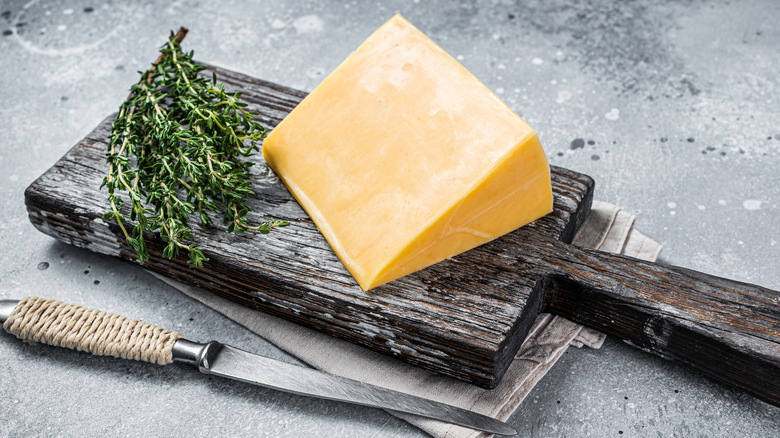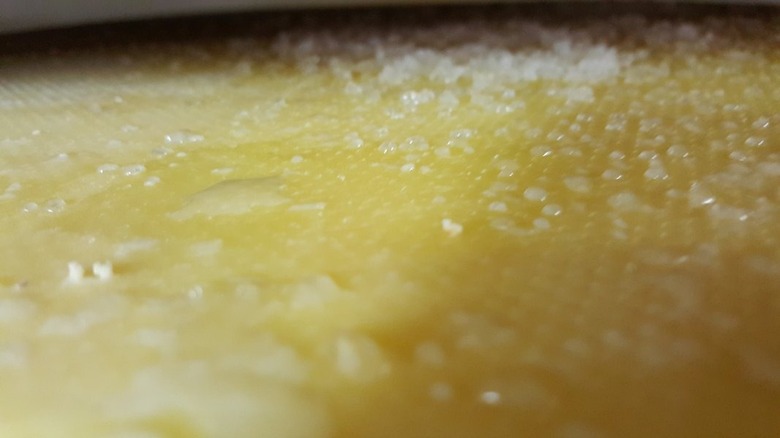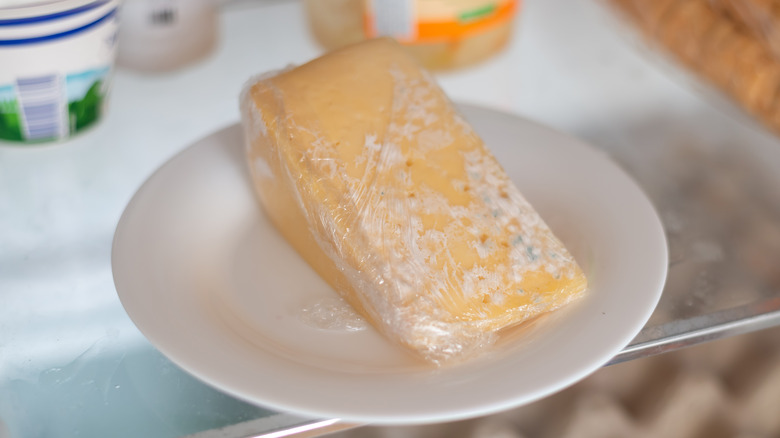Here's Why Your Cheddar Cheese Has White Stuff On It
Nobody likes to waste food (not to mention the money it costs), so opening the fridge and finding something covered in mold is always frustrating. It can happen to almost any food, but when we think of mold, most of us will first think of the same thing: cheese. Cheeses tend to have short shelf lives, often getting binned or possibly trimmed before they're fully finished. Data published by Insider estimates that dairy products account for 17.1% of global food waste. The worst part is some of that waste comes from perfectly good items that we mistakenly believe have gone bad.
Here's a scenario that many of you have undoubtedly encountered. You're hankering for a hunk of cheese, so you peep into the fridge and see a block of it covered in white speckles. This happens to many different kinds of cheese, but it is most noticeable on cheddar thanks to it being orange rather than the white hue common to most cheeses. The natural assumption to make here is that the cheese is growing mold, so you have no choice but to toss it away.
Except, that's not true. If you've ever thrown out a whitening block of cheddar, there's a good chance you missed out on perfectly fine cheese. So let's clear up the confusion now and ensure no more cheese is wasted unnecessarily.
It's not mold
Those white speckles that cheddar cheese can often bear surely look like mold growth, but thankfully they aren't. This snowy coat is actually known as calcium lactate, which is a natural byproduct of the cheesemaking process. Milk contains the simple sugar lactose, which eventually breaks down into lactic acid and binds with the calcium ions present in milk to form calcium lactate. In young cheeses and cheeses with a high moisture content, calcium lactate is invisible, but it shows up in hard cheeses the more they age. During the aging process, water gradually moves from the center of the cheese to the surface, where it evaporates. This also pulls calcium lactate from the heart of the cheese to its surface, and when the water ultimately evaporates, the calcium lactate is left behind, manifesting as powdery white crystals.
Unlike many varieties of mold, which can render your cheese inedible, calcium lactate is completely harmless. In fact, calcium lactate is widely used as a medication for treating calcium deficiency. In the context of cheese, calcium lactate can even be a sign of quality since it indicates a well-aged cheese with potentially a more robust flavor. This is why some cheesemakers and aficionados affectionately refer to calcium lactate deposits as "flavor crystals," even though they do not taste like anything on their own. Rather, the crystals are considered a promising sign of rich aged flavor.
Calcium lactate vs. mold
There's a chance that you've mistaken calcium lactate for mold in the past and missed out on perfectly good cheese, and we want to make sure that doesn't happen again. If you're trying to discern the difference between the two, your nose will be your best guide. If the cheese smells rotten, the answer is clear, and you may need to get rid of it (not necessarily though, as sometimes you can remove the mold from cheese and have a perfectly fine snack in the end). If you're not sure by the smell if your cheese is okay, it's time for the touch test. The key to telling the difference between calcium lactate and mold is in their texture. Calcium lactate crystals are coarse, like very fine sand, whereas mold is soft and sometimes sticks up from the surface of the cheese, and look like tiny hairs.
In summation: if it's furry, you should worry, but if it's rough, eat that stuff.


